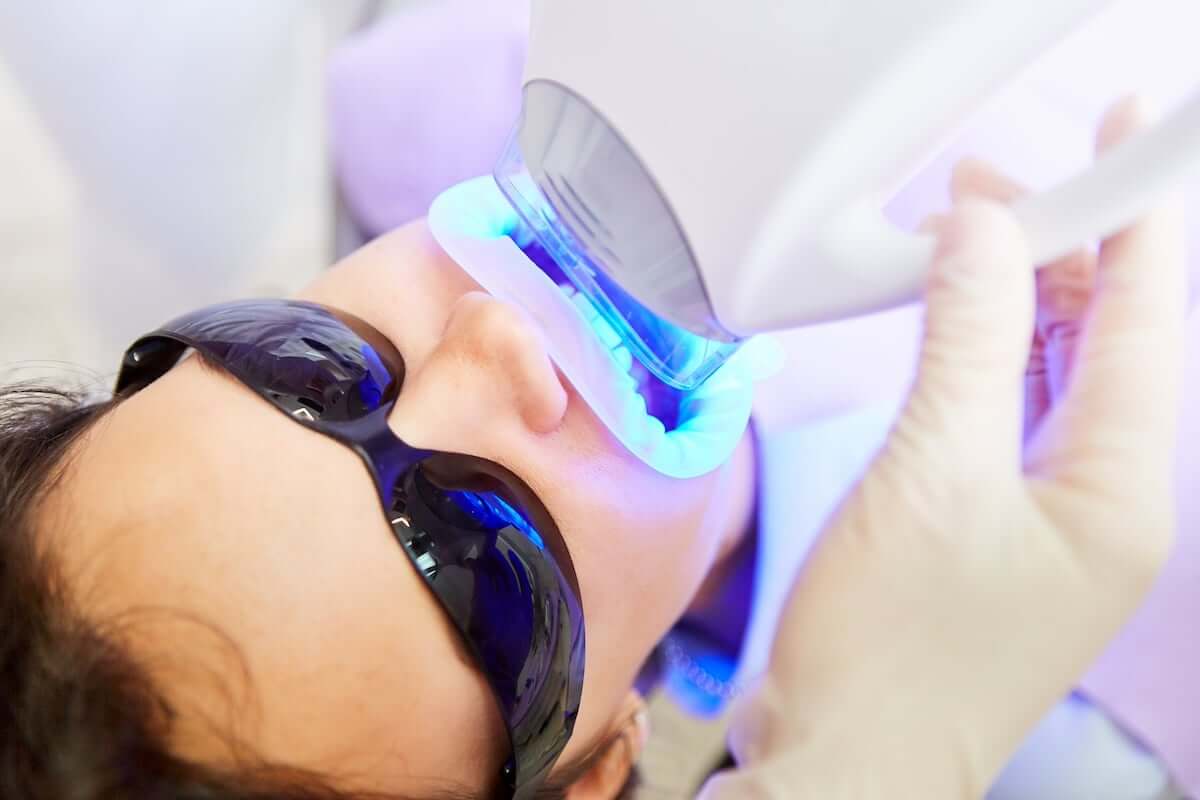A radiant, white smile can boost confidence and make a lasting impression. As the pursuit of flawless smiles continues, innovations in dental aesthetics have introduced us to blue light teeth whitening. This cutting-edge technique claims to revolutionize the teeth whitening game by promising fast and remarkable results.
But does it work? And is it safe?
In this article, we delve deep into the world of blue light teeth whitening, examining how it works, assessing its efficacy, addressing safety concerns, and exploring its place in the broader landscape of teeth whitening.
How Blue Light Teeth Whitening Works
Blue light teeth whitening, often referred to as photo-enhanced whitening, is a remarkable convergence of science and aesthetics. Combining the stain-removing power of hydrogen peroxide gel and the energy of blue light, this procedure eradicates tooth discoloration more efficiently than traditional whitening methods.
Here’s how it works:
- Hydrogen Peroxide Gel: At the heart of this process lies hydrogen peroxide gel — the key ingredient for breaking down the stubborn stains that detract from brilliant smiles. This gel permeates the enamel and dentin, targeting the chromogens responsible for discoloration. It initiates a chemical reaction on contact that dismantles these chromogens, revealing the untarnished enamel beneath.
- Blue Light Source: The other star of the show, the blue light source, is the catalyst that accelerates the bleaching process. This light emits a specific wavelength that activates the hydrogen peroxide molecules within the gel, intensifying their stain-fighting power. As these molecules become more reactive under the light’s influence, the whitening action gains momentum, resulting in a visibly brighter smile.
The Whitening Process

Picture the whitening process as a dance between molecules. The hydrogen peroxide molecules in the gel meet the chromogens in your teeth, leading to an elaborate dance on the molecular level. These molecules change their structures through a series of reactions, rendering them colorless and less likely to cause discoloration.
Unlike the gradual approach of conventional whitening methods, the combination of the gel and the blue light reduces treatment times significantly. In a matter of minutes, you can witness a noticeable shift in your teeth’s shade — a stark contrast to the time-intensive routines of the past.
Pros and Cons
Pros:
Advocates of this technique sing praises of its ability to deliver rapid results that are hard to ignore. In a world where time is of the essence, the prospect of achieving a brighter smile within a lunch break holds undeniable appeal.
The blue light is more than a decorative element. It increases the hydrogen peroxide’s efficiency. Intensifying the chemical reaction with the light turbocharges the teeth-whitening process, resulting in a more comprehensive stain removal.
The positive outcomes of blue light teeth whitening often go beyond aesthetics. For many, the confidence gained from a whiter smile improves their personal and professional lives, making this technique a potential game-changer for self-confidence.
Cons:
Not all smiles are created equal, and the same applies to the efficacy of blue light teeth whitening. Factors such as the intensity of discoloration, enamel thickness, and adherence to post-treatment care can influence the extent of improvement.
Keep in mind that while the initial transformation can be striking, maintaining that brilliance demands a commitment to oral hygiene and a mindful approach to eating and drinking habits. Regularly consuming staining agents like coffee and red wine can reverse the effects over time.
Is It Safe?
In the pursuit of a radiant smile, ensuring safety is crucial. Fortunately, when performed by an experienced dentist, blue light teeth whitening is safe. However, we don’t recommend trying this whitening method at home (unless you are using products provided by your dentist)! Here are a few reasons why:
It’s not uncommon for individuals to experience heightened tooth sensitivity during or immediately after the procedure. The good news is that this sensitivity is usually short-lived and tends to diminish as the teeth adapt to the treatment.
Another critical factor is the well-being of the gums. Precise application is crucial to prevent problems. If trays don’t fit well or excessive whitening gel is used, it can lead to gum irritation or mild burns. Having your teeth whitened by a dentist is the best way to protect yourself from unwanted side effects.
Using blue light teeth whitening excessively or too frequently could compromise the integrity of the tooth enamel. Seeking guidance from a dental professional ensures a balanced approach that maximizes the procedure's benefits while preserving overall oral health.
Understanding these safety considerations is essential for making well-informed decisions in a world where our smiles play a significant role in our self-confidence. Achieving a brighter smile is about more than just aesthetics. It’s also about choosing a method that enhances your smile and prioritizes the long-term health of your teeth and gums.
Closing Thoughts

Blue light teeth whitening is a popular option for achieving a brighter and more dazzling smile. It's evident that this technology can enhance the effects of teeth-whitening agents and speed up the whitening process. Many people report noticeable improvements in their tooth shade after undergoing blue light treatments.
Current research suggests that when used correctly and under professional supervision, blue light teeth whitening is generally safe and unlikely to harm the teeth or gums. Overuse or improper application could lead to temporary tooth sensitivity or gum irritation.
As with any dental procedure, it's crucial to consult with a qualified dentist before embarking on a blue light teeth whitening journey. They will assess your oral health, discuss the potential benefits and risks, and tailor a plan that aligns with your needs and goals.
Keep in mind that good oral hygiene practices, like regular brushing, flossing, and professional cleanings, are essential for long-term oral health and keeping your teeth sparkling white. Whether you choose blue light teeth whitening or another method, you should always balance pursuing a radiant smile with a commitment to overall oral health.
If you think blue light teeth whitening might be right for you, schedule an appointment with your dentist to learn more about the procedure and discuss your options.

